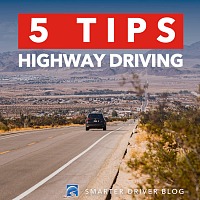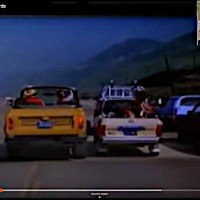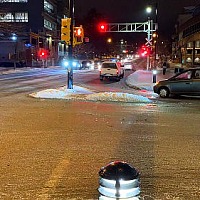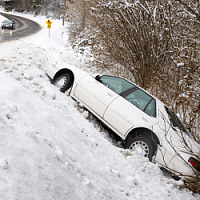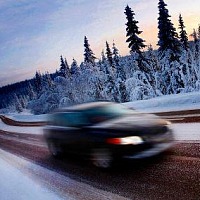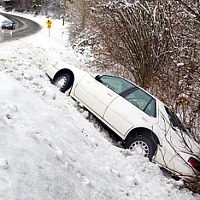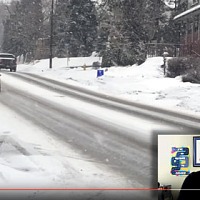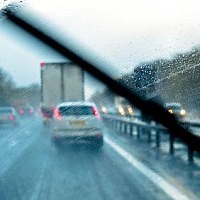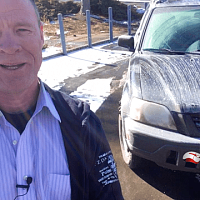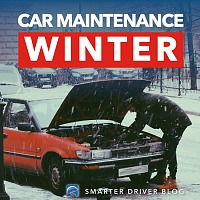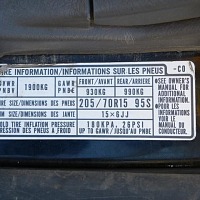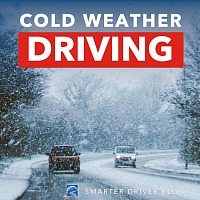Passing another vehicle and overtaking is a high-risk manoeuvre. Learn how to do it safely.
How to Pass Another Vehicle and Overtake Safely
Closed Caption
Introduction
Hi there, Smart Drivers.
Rick, with Smart Drive Test, talking today about: Passing.
Passing is one of the highest-risk maneuvers that you will execute on a two-lane highway.
A two-lane highway, with lanes of opposing traffic, going in either direction.
For those of you in the UK and Australia, and other parts of the world, where you have very narrow roads, the places of escape are very much reduced, on those narrower roads, and highways.
The other reason that you're not likely going to survive a head-on crash, is because of the distance you are from emergency services.
It takes time for emergency crews to get out to you, and to transport you to hospitals.
And, for those of you who know a little bit about health care, the "golden hour of trauma" is that first hour.
If they don't get you to medical services within the first hour, it's unlikely you're going to survive that type of car crash.
Now, there are certain engineering features on roadways, in the last decade, or so, that have significantly reduced the number of head-on collisions, that have happened on our highways, and roadways.
And, actually, now the most dangerous crash that you can be involved in is a T-bone crash.
Because, there's nothing on that side of the vehicle to protect you.
So, I was traveling back from Kamloops to Vernon, a few days ago, and traveling along Highway 97, which runs through Westwold, passed Monte Lake, and into Falkland.
And, there was a truck there, that passed another vehicle, in Westwold, BC, Canada on the two-lane highway.
And.
I thought it was a great teaching moment to show you why traffic crashes, head-on traffic crashes have been reduced significantly.
And, why, what this driver did, may not have been the most prudent move.
So, stick around.
We'll be right back, with that information.
Hi there, Smart Drivers.
Welcome back.
Rick, with Smart Drive Test, talking to you today about passing and overtaking safely.
And, why passing, and the number of Head-on crashes that have occurred, because of passing, have been significantly reduced in the last couple of decades, due to road engineering.
And, as you can see, here in the dash cam, we're coming into Westwold.
And, it's 70 kilometers an hour, which is 40 miles an hour, for a straight stretch, there.
Probably four or five kilometres, through the little rural community of Westwold, here in British Columbia.
And, the truck passes not once, passes twice.
And, the second time that the driver passes, he, or she, is out in the passing lane, for no less than twenty seconds.
Which is a long time, when you're passing on a two-lane highway, with opposing lanes of traffic.
And, I understand, very well, the pressures that are put on drivers.
There could be whatever reason: That the driver needed to get back to Armstrong.
That there was another load.
There was a family emergency.
The other driver, who was supposed to take the other load out, didn't show up, and whatnot.
And, there was pressure put on that driver, by dispatch.
However, I followed that truck, the last time I saw that truck was 47 kilometers.
47 kilometers is just a little bit less than 30 miles.
I followed that driver for 28 minutes.
And, traffic flow, along Highway 97, was 110 kilometers an hour.
I was keeping up with traffic flow, and traffic flow was doing 110 kilometers an hour.
The posted speed limit, on 97, is 90 kilometers an hour.
So, by the last time I saw that truck, 47 kilometers down the road, the average speed that we were doing, in that 47, was 100 kilometers an hour, which is 62 miles an hour.
And, that was slowing down in Falkland, to 30 miles an hour.
And, as you can see, here in the image, farther down the road here, a truck pulls up in front of me.
I actually had to slow down to 40 miles an hour, 60 kilometers an hour, to let that truck go up, so I didn't run into the truck, when he pulled out, when he, or she, pulled out in front of me, on the highway, there.
So, despite those two things: Slowing down in Falkland.
And, slowing down for the truck, that pulled out in front of me.
I was still doing an average speed of 100 kilometers an hour, 62 miles an hour.
Which is a high rate of speed.
So, I was keeping up with traffic flow, which was moving along, fairly quickly.
The other thing, about the truck, that pulled out, and passed? As we're going along, here.
In the 47 kilometers that we drove, along highway 97, there are four passing lanes.
Four passing lanes.
So, you're never more than- In the less than 28 minutes, that it took to drive the 47 kilometers, you're never more than about 10 minutes, from a passing lane.
So, the question I ask you is: Is it really worth risking your life, and risking the life of other road users, to pass, when you're no more than 8 to 10 minutes from a passing lane, at any given time?
And, you can get out and pass other vehicles.
Now, I understand in, especially here in BC, and in the Rocky Mountains, a lot of the passing lanes are on hills.
And, for truck drivers, that makes it especially frustrating.
Because, when you're on a two-lane skinny, and you're following a car, that's not doing the speed limit, or is up and down, up and down, up and down.
They're doing 80, and 90, 100, and they're down to 70, and they're back up again.
Which, is one of the most frustrating things.
So, when you're on a two-lane highway, try and maintain a constant speed.
It's frustrating for the driver of a big truck, because when you get to the passing lane, you can't pass the car, because you just don't have enough oomph to get up over the hill, because you're pulling a load.
Now, this driver in the tanker truck, that passed the cars in Westworld, was not loaded.
That driver was empty.
There was no way that that driver could have been going that fast, and have a load on.
Unless, there was a seven or eight hundred horsepower motor, under the hood.
But, I know trucks.
And, that truck was not loaded.
That truck was empty, for the speed that that truck was moving.
Features on the roadway have reduced the number of head-on crashes, that have occurred on our roadways, and highways.
And, the first road engineering feature, that has significantly reduced head-on crashes, on our highways, has been paved shoulders.
There are very few highways and byways in the world now, that do not have paved shoulders.
Maybe in some of the countries that aren't, you know, as developed as Canada, and the United States, the UK, and Australia, and other places in the world.
Paved Shoulders Reduce Head-On Crashes
But, most roadways, now, have paved shoulders.
And, the reason for that, was because, before paved shoulders, a lot of inexperienced drivers used to drop off the shoulder of the road, onto the gravel.
Panic.
Crank the steering wheel back.
Whip it back.
The vehicle would travel across the lane of traffic, and into the opposing lane of traffic, and there would be head-on crash, and there would be fatalities.
So, paved shoulders are the first engineering feature that has reduced, significantly, the number of head-on crashes, on our roadways, and highways.
The second feature, that has significantly reduced the number of head-on crashes, due to passing, is passing lanes.
There are very few highways, and byways, that you're going to go on, now, that are opposing lanes of traffic, that don't have a passing lane, every few miles, every few kilometres.
And, we were never more than 10 minutes from a passing lane.
And, the point that I'd like to make to you, is that think very carefully about passing.
Can you just relax, hang back a little bit, and wait until the passing lane comes, and then pass safely, at the passing lane?
As well, in the 47 kilometers that we traveled, along 97, South, that driver was no more, than a kilometer and a half, in front of me, by the time we got 47 kilometers down the road.
The driver didn't make any time.
Didn't increase, or decrease the amount of time it took him, or her, to drive from where we were, back to wherever they were going, on the road.
They probably saved, maybe, three or four minutes.
And, executed a high-risk maneuver, in order to do that.
So, think carefully about passing.
And, weigh out the dangerous maneuver, that you're about to execute, and how far down the road you have to get, before you can actually get to a passing lane, and do it safely.
And, are you actually going to make any time, and get farther ahead? Probably not.
Quick review of How to Pass & Overtake Safely
Two engineering features, in the last couple of decades, have significantly reduced the number of head-on crashes, that we experience on our roadways.
First, is paved shoulders.
Novice drivers aren't yanking the steering wheel back, and careening into oncoming traffic.
The second feature is, is that most two-lane highways, opposing lanes of traffic, have passing lanes, every few miles.
No more than twenty or thirty miles, are these passing lanes apart.
And, you only have to wait 10 or 15 minutes, going up and down the road, and that you're going to find another passing lane, and be able to pass safely.
And, in the case of the truck, here.
How much time did that truck actually gain? Not very much.
Because, that truck was only about a kilometer, or a kilometer and a half in front of me, by the time we got 30 miles down the road.
So, that truck didn't really make any extra time, in terms of risking those high-risk maneuvers, of passing, on a two-lane skinny highway.
And, as well, it was only 47, it was probably another 5 to 8 kilometers down the road, and the driver would have been out on a multi-lane highway.
So, what I'm saying to you, is consider, very carefully, whether you need to pass, or whether you can simply wait for the passing lane to come along.
Question for my Smart Drivers:
Have you ever moved to pass another vehicle, and then had to take evasive, emergency action, because you misjudged the gap, and the amount of space that you needed?
Did you either pullback in behind the other vehicle, or head for the shoulder, on the other side of the road?
Leave a comment, down in the comment section, there.
All that helps out the new drivers, working towards getting their license, and starting a career as a driver.
I'm Rick, with Smart Drive Test.
Thanks very much for watching.
If you like what you see here: Share, subscribe, leave a comment, down in the comment section.
As well, hit that thumbs up button.
Check out all the videos, here on the channel, if you're working towards a license, or starting a career as a truck or bus driver.
Lots of great information here.
As well, head over to our website.
Awesome online courses that you can purchase, to pass your license, regardless of which class of license that you're passing.
In May 2017, We're bringing out "Air Brakes.
Explained Simply." It's a CDL Air brake manual, that updates these very old, forty year old manuals, and tells you exactly the information that you need to know, to pass your CDL theory, and practical tests.
As well, There's 100 multiple-choice questions, that you will find on the theory test.
Thanks again for watching.
Good luck on your road test.
And, remember: Pick the best answer, not necessarily the right answer.
Have a great day.
Bye now.
Blooper
Wanted to show you this, because I..
um..
I...
I wanted to do..
what? What did I want to do? I wanted to do something, and show you something, and teach you something,

